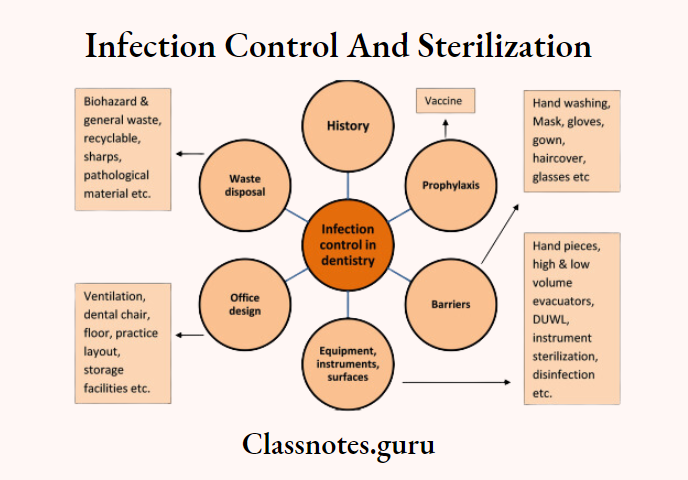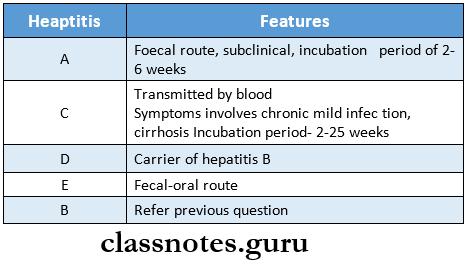Infection Control And Sterilization Important Notes
For disinfecting large bodies of water, chlorine is applied as
- Chlorine gas
- Chloramine
- Perchloron
DPT vaccine
- By it, immunization against 3 diseases can be done
- They are: Diphtheria, Pertussis and Tetanus
- Types: plain and adsorbed
- Adsorption is usually carried out by the addition of aluminum phosphate or aluminum hydroxide
- The adsorption process increases the immunological effectiveness of the vaccine
- It should not be repeated if a severe reaction occurred after a previous dose
Meningococcal vaccine
- Meningococcal vaccine is offered only to travelers at significant risk of infection
- The vaccines are purified, heat-stable, lyophilized capsular polysaccharides from meningococci
Types of polio vaccine
- Inactivated Salk polio vaccine
- Oral Sabin polio vaccine containing live attenuated virus
Read And Learn More: Percentive Communitive Dentistry Question And Answers
Herpetic whitlow
- Herpetic whitlow is a painful infection of herpes simplex and typically affects the fingers and thumb
- Herpetic whitlow can be caused by HSV-1 or HSV-2
- Herpetic whitlow lesions are commonly seen in dental workers and medical workers exposed to oral secretion
- Also observed in children with thumb-sucking habits and with primary HSV-1 oral infection.
Sterilization And Disinfection Questions
Infection Control And Sterilization Short Essays
Question 1. Infection control in the dental office.
Answer:
Personal Barriers:
- Washing and care of the hands
- The dentist should wash their hands before and after treating each patient and after touching inanimate objects
- For surgical procedures, an antimicrobial surgical hand scrub should be used
- When gloves are torn, cut, or punctured they should be removed
- Gloves
- Nonsterile- used for examination and other non-surgical procedures
- Sterile- used for surgical procedures
- Gloves should not be washed before use and should not be reused
- Gowns
- Protective clothing such as reusable/disposable gowns, laboratory coats, or uniforms should be worn when clothing is likely to be soiled with blood or other body fluids
- Reusable protective clothing should be used
- Masks/ protective eyewear
- Chin-length plastic face shields or surgical masks protect
tive eyewear should be worn when splashing or spattering of blood or other body fluids is likely to occur
- Chin-length plastic face shields or surgical masks protect
- Rubber dam
- Rubber dam minimizes the formation of droplets, spatter, and aerosols during patient treatment
Use and Care Of Sharp Instruments:
- Used needles should never be recapped
- Sharp items should be placed in appropriate puncture-resistant containers
- Bending or breaking of needles is not recommended
Sterilization Or Disinfection Of Instruments
Sterilization Methods:
- Physical
- Steam under pressure
- Diyheat
- Hydrogen peroxide
- Gas plasma
- Boiling water
- Ionizing radiation
- Chemical methods
- Acids
- Alkalis
- Aldehyde
- Chlorine
Sterilization Cleaning:
- Sterilization Cleaning is the removal of visible soil from objects
- Accomplished manually or mechanically using water with detergents or enzymatic products
Cleaning and Disinfection Of Dental Unit and Environmental Surfaces:
- Aluminum foil or plastic cover should be used to protect items and surfaces that may become contaminated
- After treatment of each patient and after completion of daily work countertops and dental unit surfaces should be cleaned with disposable toweling, using appropriate cleaning agent and water
Infection Control In Dental Practice
Question 2. Hepatitis B.
Answer:
Hepatitis B
- Described in 1965
Hepatitis B Signs and Symptoms:
- Mild flu with illness to fulminant
- Fatal liver failure
- Prodromal phase involves
- Anorexia
- Malaise
- Nausea
- Vomiting
- Fever
- Urticaria
- Arthralgia
- After 3-10 days
- Dark urine
- Jaundice
- After 1-2 weeks
- Jaundice fades and recovery begins in 2-4 weeks
- Incubation period- 45-160 days
- Sequel
- Cirrhosis
- Acute hepatitis
- Primary liver cancer
- Death
Hepatitis B Mode Of Transmission:
- Major is a blood-borne infection
- Other involve saliva and crevicular fluid
Hepatitis B Treatment:
- Effective treatment not available
- Subcutaneous administration of interferon alfa 2b was effective in inducing loss of replication of virus

Question 3. Transmissible infection in dentistry.
Answer:
Herpes Virus Infections:

Acute Viral Hepatitis:

Sterilization In Dentistry Mcqs
Acquired Immunodeficiency Syndrome:
- Human immunodeficiency virus leads to it
- Route of transmission
- Blood and other body fluids
- Signs and symptoms
- Unexplained diarrhea
- Fatigue
- Malaise
- Loss of body weight
- Fever
- Night sweat
- Oral thrush
- Generalized lymphadenopathy
- Enlarged spleen
- Opportunistic infections
Tuberculosis:
- Mycobacterium tuberculosis organism causes it
- Symptoms
- Cough of more than 3 weeks
- Sputum possibly tinged with blood
- Unexplained weight loss
- Night sweats
